Report: Finance and Funding Strategies for Eurocarib Tourism
VerifiedAdded on 2020/11/23
|18
|4303
|472
Report
AI Summary
This report provides a comprehensive analysis of finance and funding within the travel and tourism sector, using Eurocarib, a London-based European tour operator specializing in Caribbean holidays, as a case study. The report begins with an introduction to finance and funding, followed by an examination of Cost-Volume-Profit (CVP) analysis and its importance in financial management, exploring pricing methods, and factors influencing profit. It further investigates various types of management accounting information, investment appraisal techniques, and the interpretation of financial statements. The report also analyzes sources of funding and distribution within the context of Eurocarib's operations, offering insights into financial strategies and decision-making processes within the tourism industry. The report covers topics such as market oriented pricing, penetration pricing, seasonal variations, and economic factors that affect the tourism sector. The report uses net present value (NPV) as an investment appraisal technique for decision making.

FINANCE AND FUNDING IN
TRAVEL AND TOURISM
SECTOR
TRAVEL AND TOURISM
SECTOR
Paraphrase This Document
Need a fresh take? Get an instant paraphrase of this document with our AI Paraphraser

TABLE OF CONTENTS
INTRODUCTION...........................................................................................................................1
TASK 1............................................................................................................................................1
A. Examining concept of CVP analysis along with its importance in financial management of
EUROCARIB..............................................................................................................................1
D1.................................................................................................................................................2
B. Analysing pricing methods used for identifying price to charge every tourist.......................3
C. Analysing factors which influence profit of Eurocarib would earn on holiday trip...............4
TASK 2............................................................................................................................................4
A. Explaining various types of management accounting information used in Eurocarib...........4
B. Assessing application of investment appraisal techniques as tool of decision making..........6
TASK 3............................................................................................................................................9
A. Interpreting financial statements with application of profitability, investment and liquidity.9
TASK 4..........................................................................................................................................12
A. Analysing sources and funding distribution of funding........................................................12
CONCLUSION..............................................................................................................................13
REFERENCES..............................................................................................................................14
INTRODUCTION...........................................................................................................................1
TASK 1............................................................................................................................................1
A. Examining concept of CVP analysis along with its importance in financial management of
EUROCARIB..............................................................................................................................1
D1.................................................................................................................................................2
B. Analysing pricing methods used for identifying price to charge every tourist.......................3
C. Analysing factors which influence profit of Eurocarib would earn on holiday trip...............4
TASK 2............................................................................................................................................4
A. Explaining various types of management accounting information used in Eurocarib...........4
B. Assessing application of investment appraisal techniques as tool of decision making..........6
TASK 3............................................................................................................................................9
A. Interpreting financial statements with application of profitability, investment and liquidity.9
TASK 4..........................................................................................................................................12
A. Analysing sources and funding distribution of funding........................................................12
CONCLUSION..............................................................................................................................13
REFERENCES..............................................................................................................................14
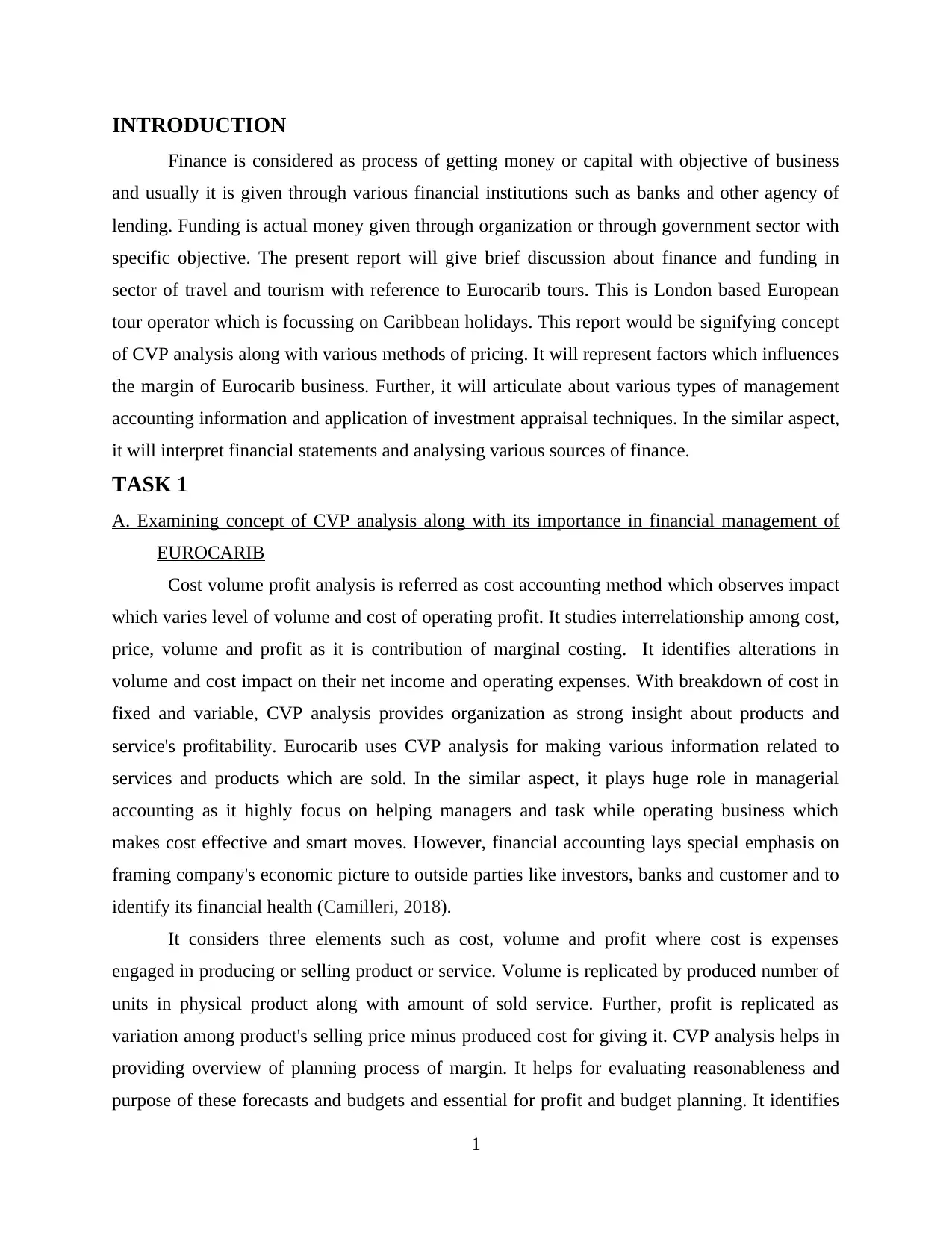
INTRODUCTION
Finance is considered as process of getting money or capital with objective of business
and usually it is given through various financial institutions such as banks and other agency of
lending. Funding is actual money given through organization or through government sector with
specific objective. The present report will give brief discussion about finance and funding in
sector of travel and tourism with reference to Eurocarib tours. This is London based European
tour operator which is focussing on Caribbean holidays. This report would be signifying concept
of CVP analysis along with various methods of pricing. It will represent factors which influences
the margin of Eurocarib business. Further, it will articulate about various types of management
accounting information and application of investment appraisal techniques. In the similar aspect,
it will interpret financial statements and analysing various sources of finance.
TASK 1
A. Examining concept of CVP analysis along with its importance in financial management of
EUROCARIB
Cost volume profit analysis is referred as cost accounting method which observes impact
which varies level of volume and cost of operating profit. It studies interrelationship among cost,
price, volume and profit as it is contribution of marginal costing. It identifies alterations in
volume and cost impact on their net income and operating expenses. With breakdown of cost in
fixed and variable, CVP analysis provides organization as strong insight about products and
service's profitability. Eurocarib uses CVP analysis for making various information related to
services and products which are sold. In the similar aspect, it plays huge role in managerial
accounting as it highly focus on helping managers and task while operating business which
makes cost effective and smart moves. However, financial accounting lays special emphasis on
framing company's economic picture to outside parties like investors, banks and customer and to
identify its financial health (Camilleri, 2018).
It considers three elements such as cost, volume and profit where cost is expenses
engaged in producing or selling product or service. Volume is replicated by produced number of
units in physical product along with amount of sold service. Further, profit is replicated as
variation among product's selling price minus produced cost for giving it. CVP analysis helps in
providing overview of planning process of margin. It helps for evaluating reasonableness and
purpose of these forecasts and budgets and essential for profit and budget planning. It identifies
1
Finance is considered as process of getting money or capital with objective of business
and usually it is given through various financial institutions such as banks and other agency of
lending. Funding is actual money given through organization or through government sector with
specific objective. The present report will give brief discussion about finance and funding in
sector of travel and tourism with reference to Eurocarib tours. This is London based European
tour operator which is focussing on Caribbean holidays. This report would be signifying concept
of CVP analysis along with various methods of pricing. It will represent factors which influences
the margin of Eurocarib business. Further, it will articulate about various types of management
accounting information and application of investment appraisal techniques. In the similar aspect,
it will interpret financial statements and analysing various sources of finance.
TASK 1
A. Examining concept of CVP analysis along with its importance in financial management of
EUROCARIB
Cost volume profit analysis is referred as cost accounting method which observes impact
which varies level of volume and cost of operating profit. It studies interrelationship among cost,
price, volume and profit as it is contribution of marginal costing. It identifies alterations in
volume and cost impact on their net income and operating expenses. With breakdown of cost in
fixed and variable, CVP analysis provides organization as strong insight about products and
service's profitability. Eurocarib uses CVP analysis for making various information related to
services and products which are sold. In the similar aspect, it plays huge role in managerial
accounting as it highly focus on helping managers and task while operating business which
makes cost effective and smart moves. However, financial accounting lays special emphasis on
framing company's economic picture to outside parties like investors, banks and customer and to
identify its financial health (Camilleri, 2018).
It considers three elements such as cost, volume and profit where cost is expenses
engaged in producing or selling product or service. Volume is replicated by produced number of
units in physical product along with amount of sold service. Further, profit is replicated as
variation among product's selling price minus produced cost for giving it. CVP analysis helps in
providing overview of planning process of margin. It helps for evaluating reasonableness and
purpose of these forecasts and budgets and essential for profit and budget planning. It identifies
1
⊘ This is a preview!⊘
Do you want full access?
Subscribe today to unlock all pages.

Trusted by 1+ million students worldwide
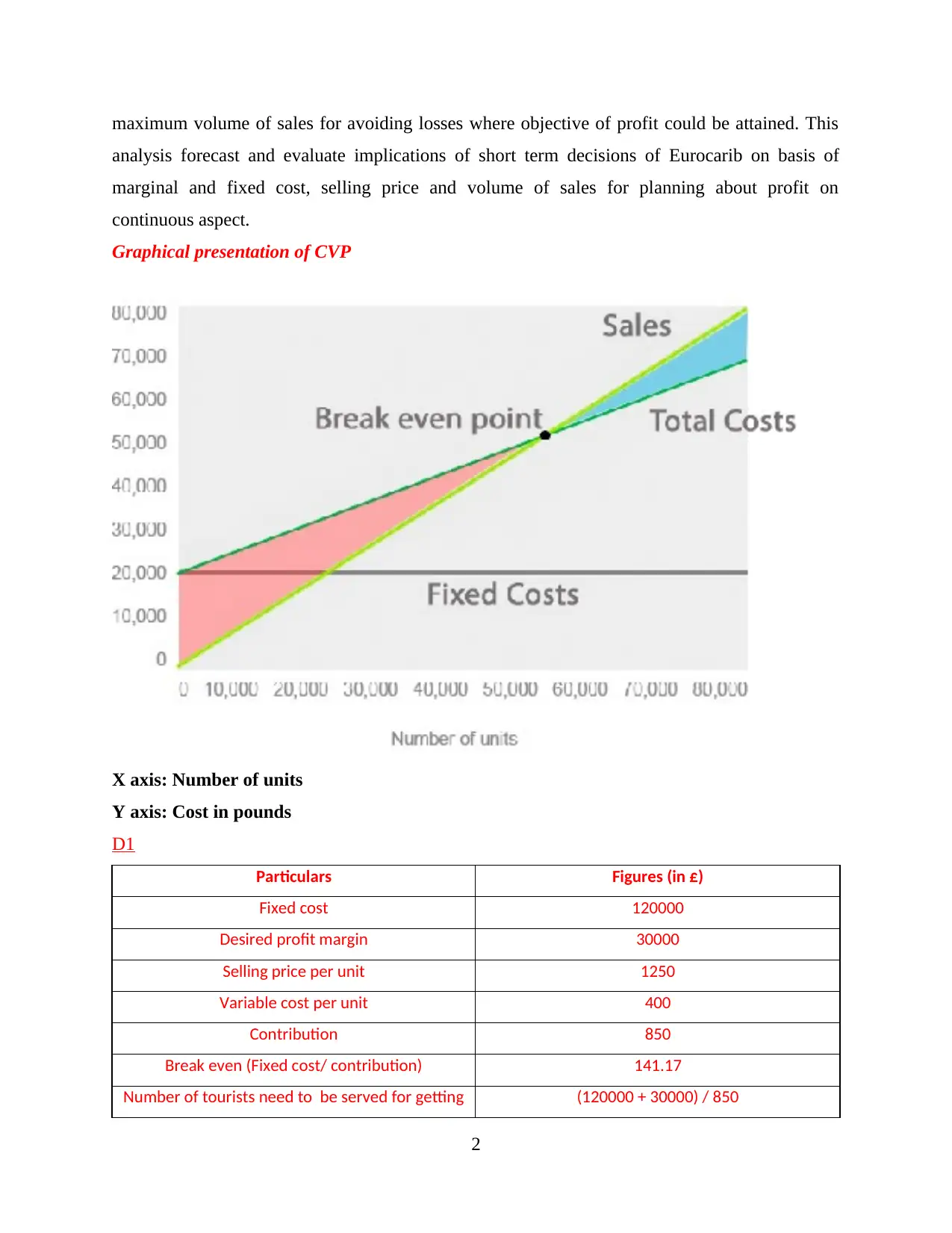
maximum volume of sales for avoiding losses where objective of profit could be attained. This
analysis forecast and evaluate implications of short term decisions of Eurocarib on basis of
marginal and fixed cost, selling price and volume of sales for planning about profit on
continuous aspect.
Graphical presentation of CVP
X axis: Number of units
Y axis: Cost in pounds
D1
Particulars Figures (in £)
Fixed cost 120000
Desired profit margin 30000
Selling price per unit 1250
Variable cost per unit 400
Contribution 850
Break even (Fixed cost/ contribution) 141.17
Number of tourists need to be served for getting (120000 + 30000) / 850
2
analysis forecast and evaluate implications of short term decisions of Eurocarib on basis of
marginal and fixed cost, selling price and volume of sales for planning about profit on
continuous aspect.
Graphical presentation of CVP
X axis: Number of units
Y axis: Cost in pounds
D1
Particulars Figures (in £)
Fixed cost 120000
Desired profit margin 30000
Selling price per unit 1250
Variable cost per unit 400
Contribution 850
Break even (Fixed cost/ contribution) 141.17
Number of tourists need to be served for getting (120000 + 30000) / 850
2
Paraphrase This Document
Need a fresh take? Get an instant paraphrase of this document with our AI Paraphraser
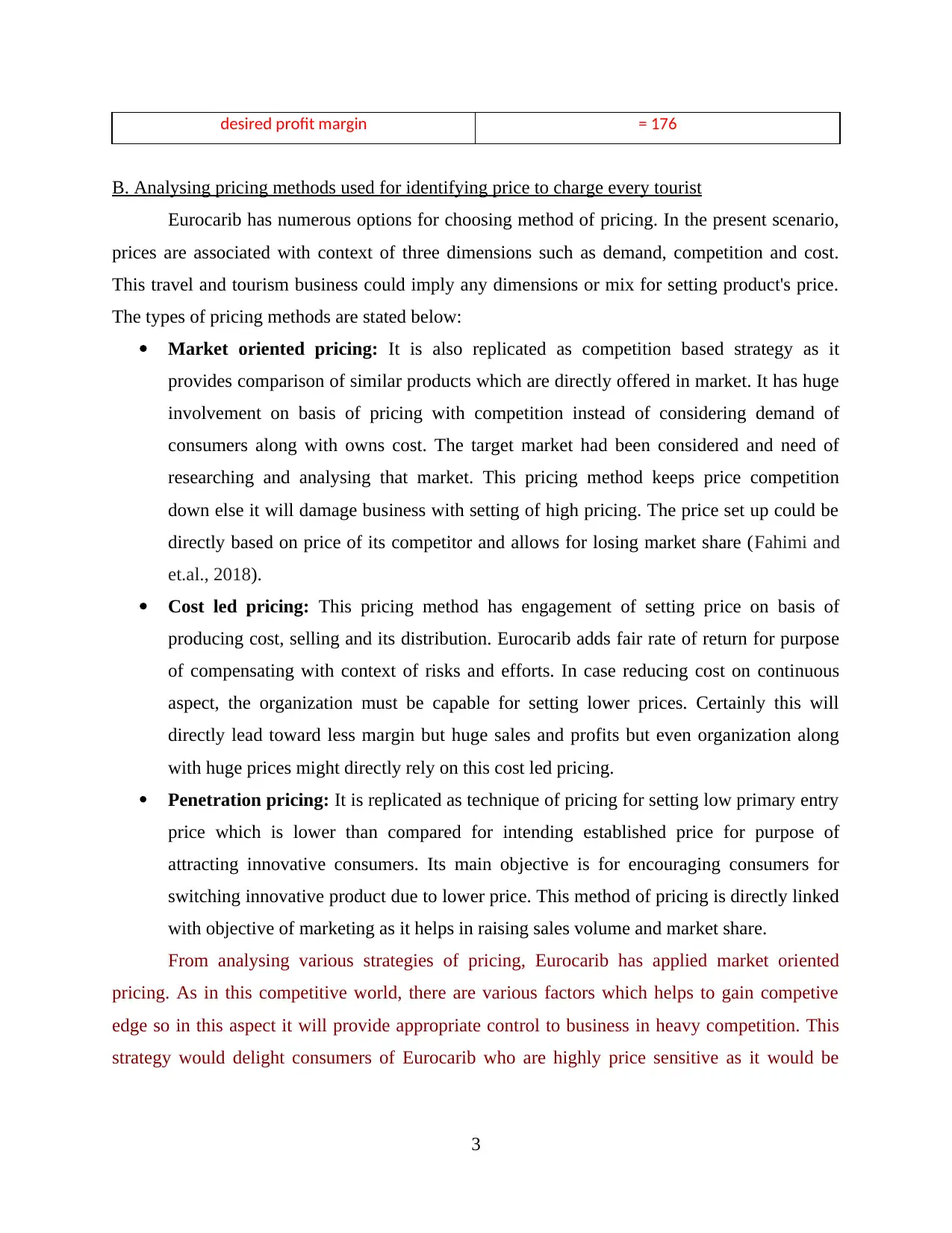
desired profit margin = 176
B. Analysing pricing methods used for identifying price to charge every tourist
Eurocarib has numerous options for choosing method of pricing. In the present scenario,
prices are associated with context of three dimensions such as demand, competition and cost.
This travel and tourism business could imply any dimensions or mix for setting product's price.
The types of pricing methods are stated below:
Market oriented pricing: It is also replicated as competition based strategy as it
provides comparison of similar products which are directly offered in market. It has huge
involvement on basis of pricing with competition instead of considering demand of
consumers along with owns cost. The target market had been considered and need of
researching and analysing that market. This pricing method keeps price competition
down else it will damage business with setting of high pricing. The price set up could be
directly based on price of its competitor and allows for losing market share (Fahimi and
et.al., 2018).
Cost led pricing: This pricing method has engagement of setting price on basis of
producing cost, selling and its distribution. Eurocarib adds fair rate of return for purpose
of compensating with context of risks and efforts. In case reducing cost on continuous
aspect, the organization must be capable for setting lower prices. Certainly this will
directly lead toward less margin but huge sales and profits but even organization along
with huge prices might directly rely on this cost led pricing.
Penetration pricing: It is replicated as technique of pricing for setting low primary entry
price which is lower than compared for intending established price for purpose of
attracting innovative consumers. Its main objective is for encouraging consumers for
switching innovative product due to lower price. This method of pricing is directly linked
with objective of marketing as it helps in raising sales volume and market share.
From analysing various strategies of pricing, Eurocarib has applied market oriented
pricing. As in this competitive world, there are various factors which helps to gain competive
edge so in this aspect it will provide appropriate control to business in heavy competition. This
strategy would delight consumers of Eurocarib who are highly price sensitive as it would be
3
B. Analysing pricing methods used for identifying price to charge every tourist
Eurocarib has numerous options for choosing method of pricing. In the present scenario,
prices are associated with context of three dimensions such as demand, competition and cost.
This travel and tourism business could imply any dimensions or mix for setting product's price.
The types of pricing methods are stated below:
Market oriented pricing: It is also replicated as competition based strategy as it
provides comparison of similar products which are directly offered in market. It has huge
involvement on basis of pricing with competition instead of considering demand of
consumers along with owns cost. The target market had been considered and need of
researching and analysing that market. This pricing method keeps price competition
down else it will damage business with setting of high pricing. The price set up could be
directly based on price of its competitor and allows for losing market share (Fahimi and
et.al., 2018).
Cost led pricing: This pricing method has engagement of setting price on basis of
producing cost, selling and its distribution. Eurocarib adds fair rate of return for purpose
of compensating with context of risks and efforts. In case reducing cost on continuous
aspect, the organization must be capable for setting lower prices. Certainly this will
directly lead toward less margin but huge sales and profits but even organization along
with huge prices might directly rely on this cost led pricing.
Penetration pricing: It is replicated as technique of pricing for setting low primary entry
price which is lower than compared for intending established price for purpose of
attracting innovative consumers. Its main objective is for encouraging consumers for
switching innovative product due to lower price. This method of pricing is directly linked
with objective of marketing as it helps in raising sales volume and market share.
From analysing various strategies of pricing, Eurocarib has applied market oriented
pricing. As in this competitive world, there are various factors which helps to gain competive
edge so in this aspect it will provide appropriate control to business in heavy competition. This
strategy would delight consumers of Eurocarib who are highly price sensitive as it would be
3
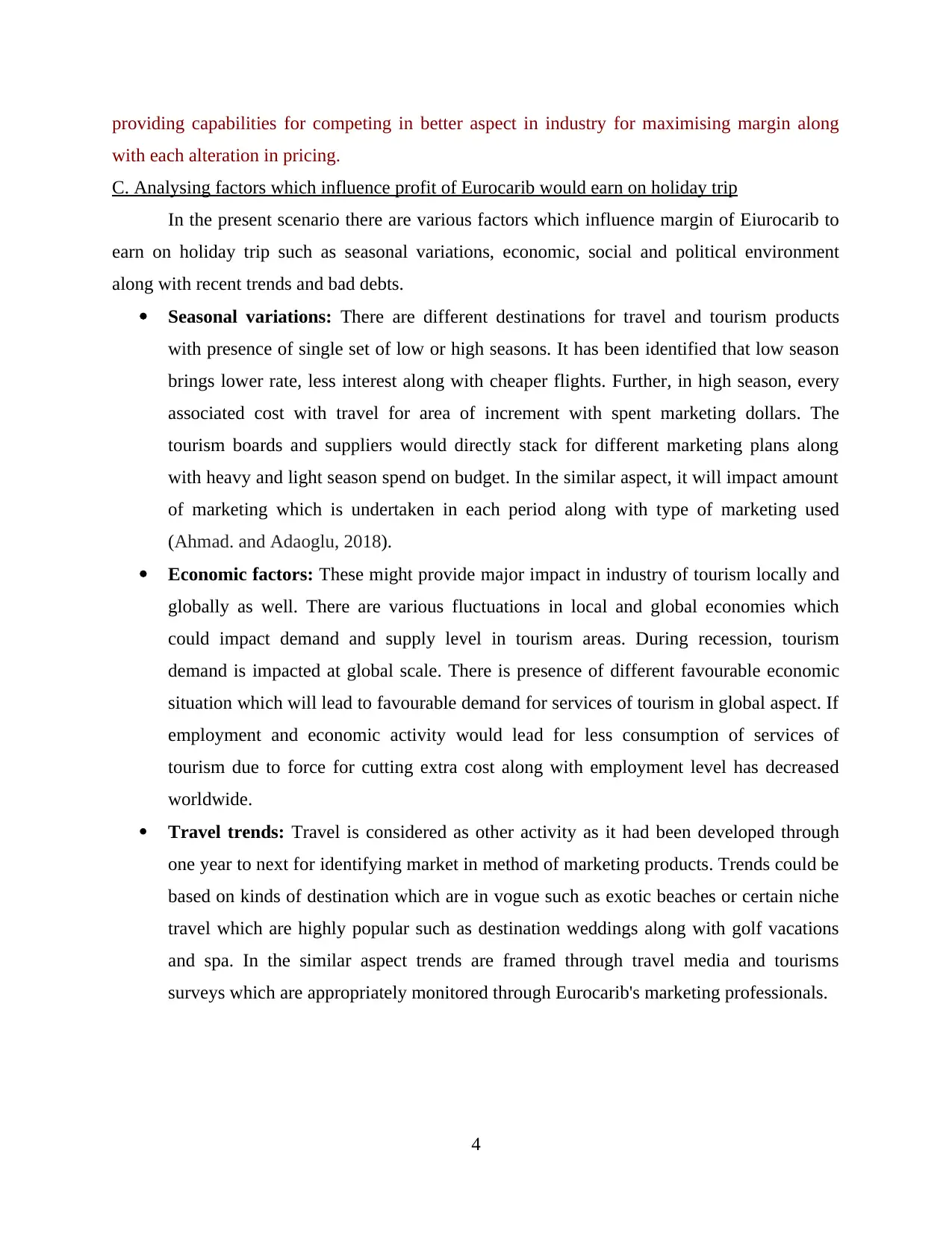
providing capabilities for competing in better aspect in industry for maximising margin along
with each alteration in pricing.
C. Analysing factors which influence profit of Eurocarib would earn on holiday trip
In the present scenario there are various factors which influence margin of Eiurocarib to
earn on holiday trip such as seasonal variations, economic, social and political environment
along with recent trends and bad debts.
Seasonal variations: There are different destinations for travel and tourism products
with presence of single set of low or high seasons. It has been identified that low season
brings lower rate, less interest along with cheaper flights. Further, in high season, every
associated cost with travel for area of increment with spent marketing dollars. The
tourism boards and suppliers would directly stack for different marketing plans along
with heavy and light season spend on budget. In the similar aspect, it will impact amount
of marketing which is undertaken in each period along with type of marketing used
(Ahmad. and Adaoglu, 2018).
Economic factors: These might provide major impact in industry of tourism locally and
globally as well. There are various fluctuations in local and global economies which
could impact demand and supply level in tourism areas. During recession, tourism
demand is impacted at global scale. There is presence of different favourable economic
situation which will lead to favourable demand for services of tourism in global aspect. If
employment and economic activity would lead for less consumption of services of
tourism due to force for cutting extra cost along with employment level has decreased
worldwide.
Travel trends: Travel is considered as other activity as it had been developed through
one year to next for identifying market in method of marketing products. Trends could be
based on kinds of destination which are in vogue such as exotic beaches or certain niche
travel which are highly popular such as destination weddings along with golf vacations
and spa. In the similar aspect trends are framed through travel media and tourisms
surveys which are appropriately monitored through Eurocarib's marketing professionals.
4
with each alteration in pricing.
C. Analysing factors which influence profit of Eurocarib would earn on holiday trip
In the present scenario there are various factors which influence margin of Eiurocarib to
earn on holiday trip such as seasonal variations, economic, social and political environment
along with recent trends and bad debts.
Seasonal variations: There are different destinations for travel and tourism products
with presence of single set of low or high seasons. It has been identified that low season
brings lower rate, less interest along with cheaper flights. Further, in high season, every
associated cost with travel for area of increment with spent marketing dollars. The
tourism boards and suppliers would directly stack for different marketing plans along
with heavy and light season spend on budget. In the similar aspect, it will impact amount
of marketing which is undertaken in each period along with type of marketing used
(Ahmad. and Adaoglu, 2018).
Economic factors: These might provide major impact in industry of tourism locally and
globally as well. There are various fluctuations in local and global economies which
could impact demand and supply level in tourism areas. During recession, tourism
demand is impacted at global scale. There is presence of different favourable economic
situation which will lead to favourable demand for services of tourism in global aspect. If
employment and economic activity would lead for less consumption of services of
tourism due to force for cutting extra cost along with employment level has decreased
worldwide.
Travel trends: Travel is considered as other activity as it had been developed through
one year to next for identifying market in method of marketing products. Trends could be
based on kinds of destination which are in vogue such as exotic beaches or certain niche
travel which are highly popular such as destination weddings along with golf vacations
and spa. In the similar aspect trends are framed through travel media and tourisms
surveys which are appropriately monitored through Eurocarib's marketing professionals.
4
⊘ This is a preview!⊘
Do you want full access?
Subscribe today to unlock all pages.

Trusted by 1+ million students worldwide
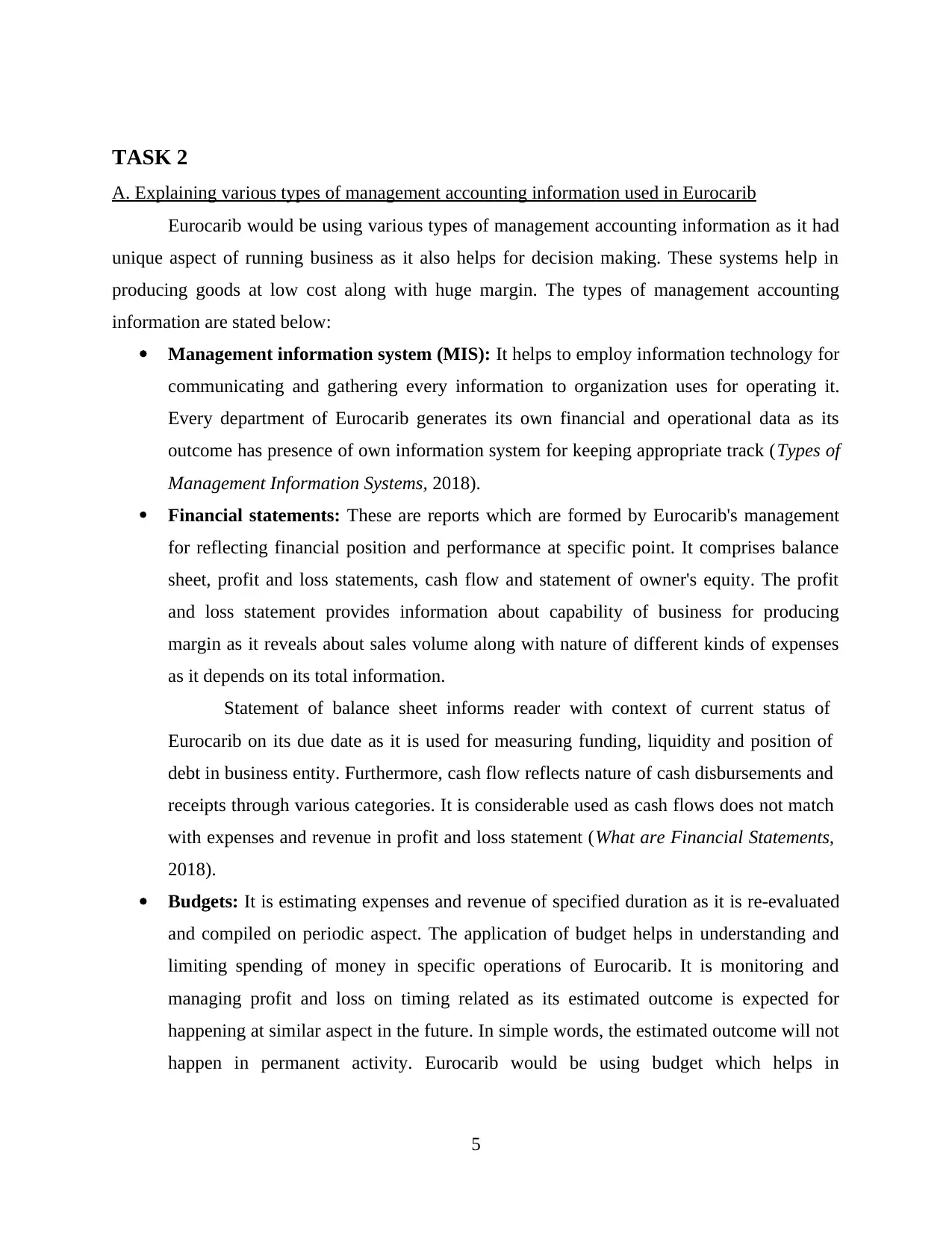
TASK 2
A. Explaining various types of management accounting information used in Eurocarib
Eurocarib would be using various types of management accounting information as it had
unique aspect of running business as it also helps for decision making. These systems help in
producing goods at low cost along with huge margin. The types of management accounting
information are stated below:
Management information system (MIS): It helps to employ information technology for
communicating and gathering every information to organization uses for operating it.
Every department of Eurocarib generates its own financial and operational data as its
outcome has presence of own information system for keeping appropriate track (Types of
Management Information Systems, 2018).
Financial statements: These are reports which are formed by Eurocarib's management
for reflecting financial position and performance at specific point. It comprises balance
sheet, profit and loss statements, cash flow and statement of owner's equity. The profit
and loss statement provides information about capability of business for producing
margin as it reveals about sales volume along with nature of different kinds of expenses
as it depends on its total information.
Statement of balance sheet informs reader with context of current status of
Eurocarib on its due date as it is used for measuring funding, liquidity and position of
debt in business entity. Furthermore, cash flow reflects nature of cash disbursements and
receipts through various categories. It is considerable used as cash flows does not match
with expenses and revenue in profit and loss statement (What are Financial Statements,
2018).
Budgets: It is estimating expenses and revenue of specified duration as it is re-evaluated
and compiled on periodic aspect. The application of budget helps in understanding and
limiting spending of money in specific operations of Eurocarib. It is monitoring and
managing profit and loss on timing related as its estimated outcome is expected for
happening at similar aspect in the future. In simple words, the estimated outcome will not
happen in permanent activity. Eurocarib would be using budget which helps in
5
A. Explaining various types of management accounting information used in Eurocarib
Eurocarib would be using various types of management accounting information as it had
unique aspect of running business as it also helps for decision making. These systems help in
producing goods at low cost along with huge margin. The types of management accounting
information are stated below:
Management information system (MIS): It helps to employ information technology for
communicating and gathering every information to organization uses for operating it.
Every department of Eurocarib generates its own financial and operational data as its
outcome has presence of own information system for keeping appropriate track (Types of
Management Information Systems, 2018).
Financial statements: These are reports which are formed by Eurocarib's management
for reflecting financial position and performance at specific point. It comprises balance
sheet, profit and loss statements, cash flow and statement of owner's equity. The profit
and loss statement provides information about capability of business for producing
margin as it reveals about sales volume along with nature of different kinds of expenses
as it depends on its total information.
Statement of balance sheet informs reader with context of current status of
Eurocarib on its due date as it is used for measuring funding, liquidity and position of
debt in business entity. Furthermore, cash flow reflects nature of cash disbursements and
receipts through various categories. It is considerable used as cash flows does not match
with expenses and revenue in profit and loss statement (What are Financial Statements,
2018).
Budgets: It is estimating expenses and revenue of specified duration as it is re-evaluated
and compiled on periodic aspect. The application of budget helps in understanding and
limiting spending of money in specific operations of Eurocarib. It is monitoring and
managing profit and loss on timing related as its estimated outcome is expected for
happening at similar aspect in the future. In simple words, the estimated outcome will not
happen in permanent activity. Eurocarib would be using budget which helps in
5
Paraphrase This Document
Need a fresh take? Get an instant paraphrase of this document with our AI Paraphraser
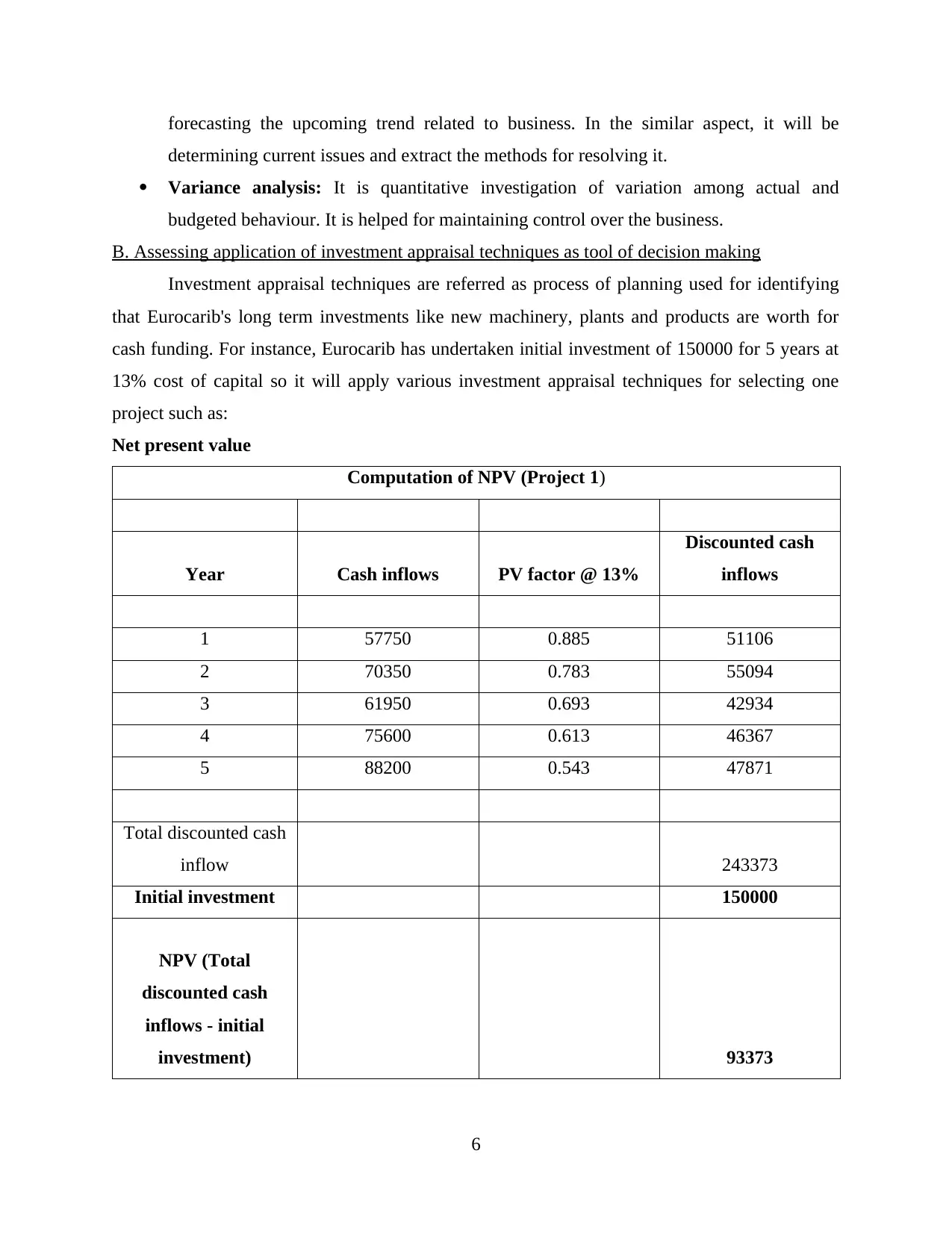
forecasting the upcoming trend related to business. In the similar aspect, it will be
determining current issues and extract the methods for resolving it.
Variance analysis: It is quantitative investigation of variation among actual and
budgeted behaviour. It is helped for maintaining control over the business.
B. Assessing application of investment appraisal techniques as tool of decision making
Investment appraisal techniques are referred as process of planning used for identifying
that Eurocarib's long term investments like new machinery, plants and products are worth for
cash funding. For instance, Eurocarib has undertaken initial investment of 150000 for 5 years at
13% cost of capital so it will apply various investment appraisal techniques for selecting one
project such as:
Net present value
Computation of NPV (Project 1)
Year Cash inflows PV factor @ 13%
Discounted cash
inflows
1 57750 0.885 51106
2 70350 0.783 55094
3 61950 0.693 42934
4 75600 0.613 46367
5 88200 0.543 47871
Total discounted cash
inflow 243373
Initial investment 150000
NPV (Total
discounted cash
inflows - initial
investment) 93373
6
determining current issues and extract the methods for resolving it.
Variance analysis: It is quantitative investigation of variation among actual and
budgeted behaviour. It is helped for maintaining control over the business.
B. Assessing application of investment appraisal techniques as tool of decision making
Investment appraisal techniques are referred as process of planning used for identifying
that Eurocarib's long term investments like new machinery, plants and products are worth for
cash funding. For instance, Eurocarib has undertaken initial investment of 150000 for 5 years at
13% cost of capital so it will apply various investment appraisal techniques for selecting one
project such as:
Net present value
Computation of NPV (Project 1)
Year Cash inflows PV factor @ 13%
Discounted cash
inflows
1 57750 0.885 51106
2 70350 0.783 55094
3 61950 0.693 42934
4 75600 0.613 46367
5 88200 0.543 47871
Total discounted cash
inflow 243373
Initial investment 150000
NPV (Total
discounted cash
inflows - initial
investment) 93373
6
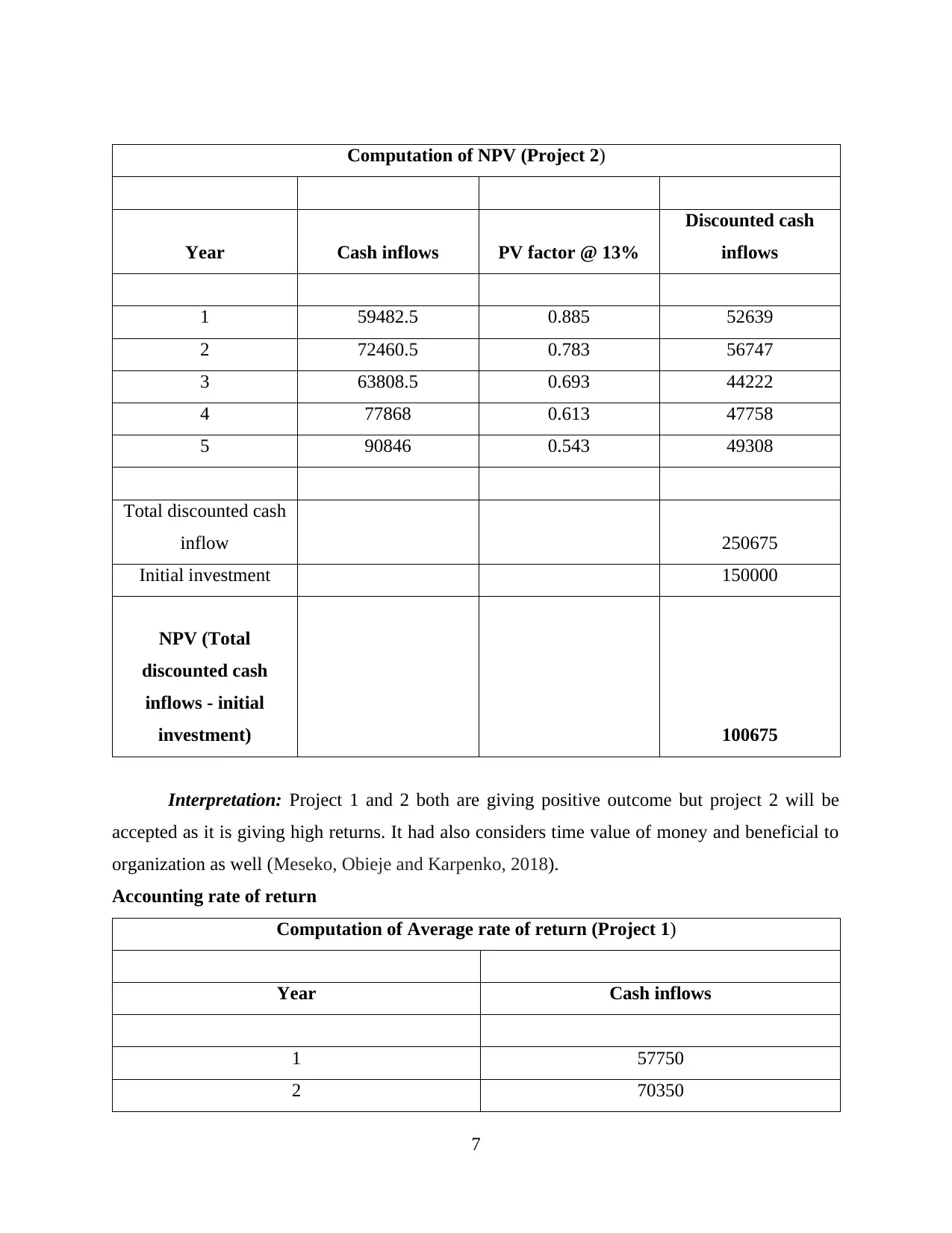
Computation of NPV (Project 2)
Year Cash inflows PV factor @ 13%
Discounted cash
inflows
1 59482.5 0.885 52639
2 72460.5 0.783 56747
3 63808.5 0.693 44222
4 77868 0.613 47758
5 90846 0.543 49308
Total discounted cash
inflow 250675
Initial investment 150000
NPV (Total
discounted cash
inflows - initial
investment) 100675
Interpretation: Project 1 and 2 both are giving positive outcome but project 2 will be
accepted as it is giving high returns. It had also considers time value of money and beneficial to
organization as well (Meseko, Obieje and Karpenko, 2018).
Accounting rate of return
Computation of Average rate of return (Project 1)
Year Cash inflows
1 57750
2 70350
7
Year Cash inflows PV factor @ 13%
Discounted cash
inflows
1 59482.5 0.885 52639
2 72460.5 0.783 56747
3 63808.5 0.693 44222
4 77868 0.613 47758
5 90846 0.543 49308
Total discounted cash
inflow 250675
Initial investment 150000
NPV (Total
discounted cash
inflows - initial
investment) 100675
Interpretation: Project 1 and 2 both are giving positive outcome but project 2 will be
accepted as it is giving high returns. It had also considers time value of money and beneficial to
organization as well (Meseko, Obieje and Karpenko, 2018).
Accounting rate of return
Computation of Average rate of return (Project 1)
Year Cash inflows
1 57750
2 70350
7
⊘ This is a preview!⊘
Do you want full access?
Subscribe today to unlock all pages.

Trusted by 1+ million students worldwide
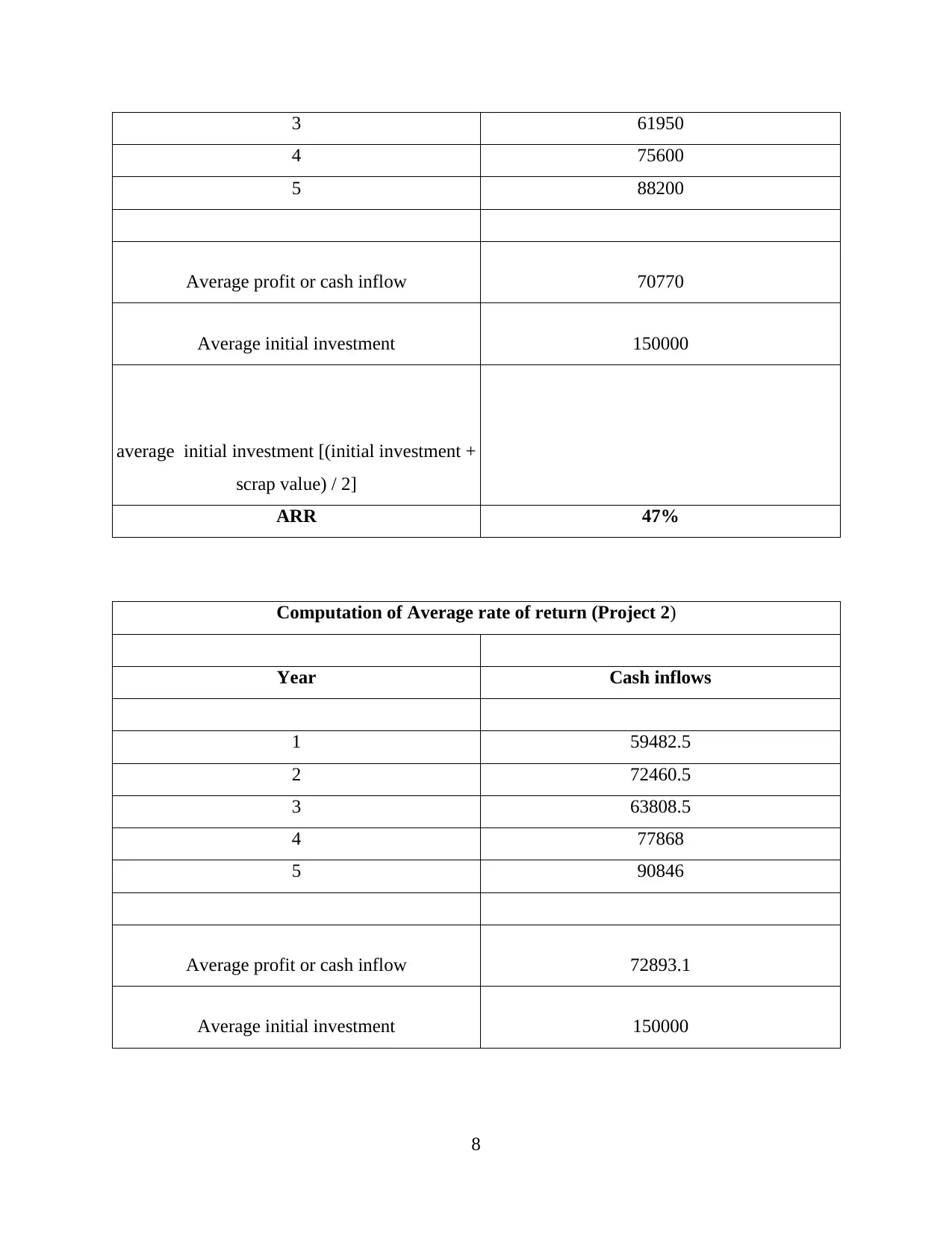
3 61950
4 75600
5 88200
Average profit or cash inflow 70770
Average initial investment 150000
average initial investment [(initial investment +
scrap value) / 2]
ARR 47%
Computation of Average rate of return (Project 2)
Year Cash inflows
1 59482.5
2 72460.5
3 63808.5
4 77868
5 90846
Average profit or cash inflow 72893.1
Average initial investment 150000
8
4 75600
5 88200
Average profit or cash inflow 70770
Average initial investment 150000
average initial investment [(initial investment +
scrap value) / 2]
ARR 47%
Computation of Average rate of return (Project 2)
Year Cash inflows
1 59482.5
2 72460.5
3 63808.5
4 77868
5 90846
Average profit or cash inflow 72893.1
Average initial investment 150000
8
Paraphrase This Document
Need a fresh take? Get an instant paraphrase of this document with our AI Paraphraser
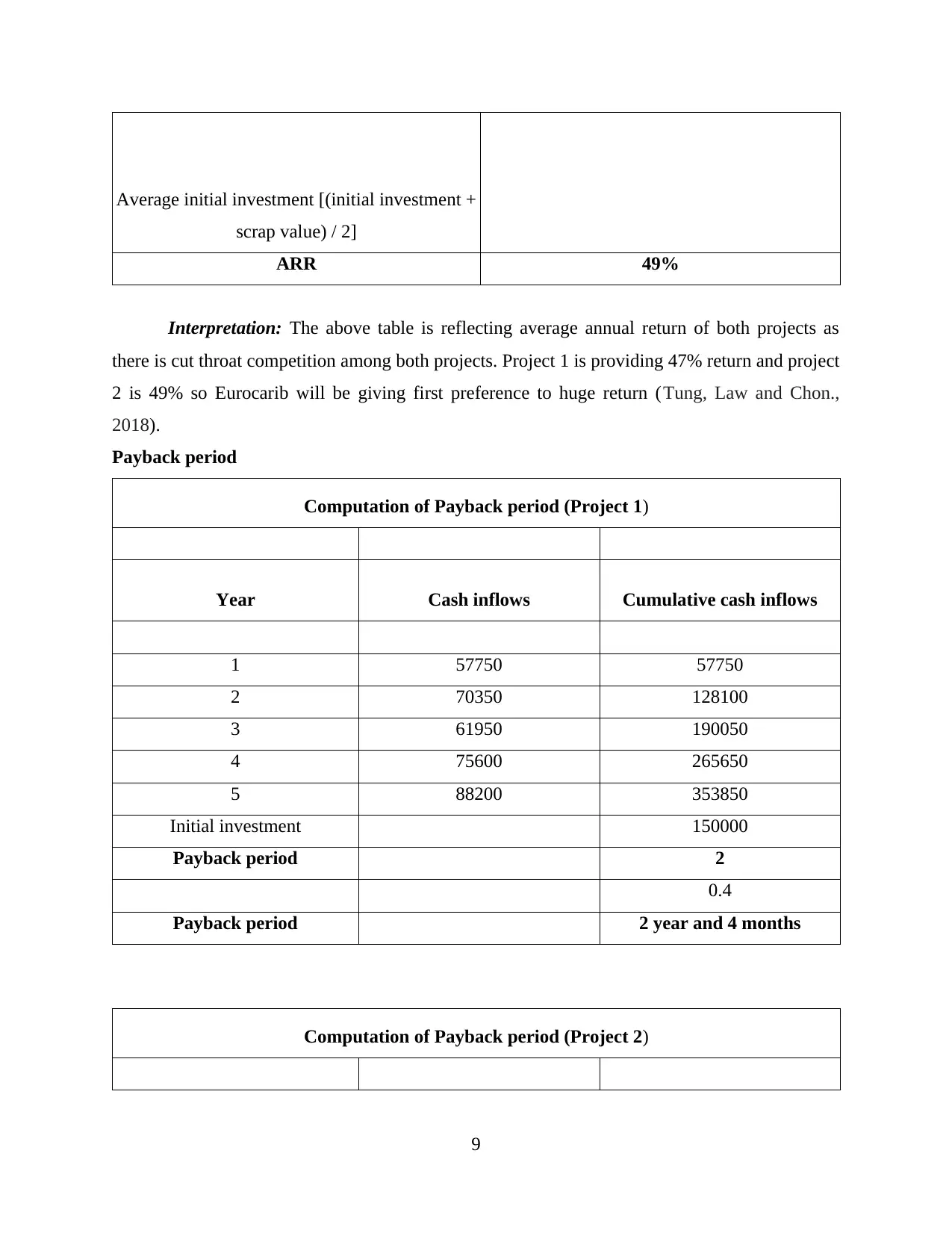
Average initial investment [(initial investment +
scrap value) / 2]
ARR 49%
Interpretation: The above table is reflecting average annual return of both projects as
there is cut throat competition among both projects. Project 1 is providing 47% return and project
2 is 49% so Eurocarib will be giving first preference to huge return (Tung, Law and Chon.,
2018).
Payback period
Computation of Payback period (Project 1)
Year Cash inflows Cumulative cash inflows
1 57750 57750
2 70350 128100
3 61950 190050
4 75600 265650
5 88200 353850
Initial investment 150000
Payback period 2
0.4
Payback period 2 year and 4 months
Computation of Payback period (Project 2)
9
scrap value) / 2]
ARR 49%
Interpretation: The above table is reflecting average annual return of both projects as
there is cut throat competition among both projects. Project 1 is providing 47% return and project
2 is 49% so Eurocarib will be giving first preference to huge return (Tung, Law and Chon.,
2018).
Payback period
Computation of Payback period (Project 1)
Year Cash inflows Cumulative cash inflows
1 57750 57750
2 70350 128100
3 61950 190050
4 75600 265650
5 88200 353850
Initial investment 150000
Payback period 2
0.4
Payback period 2 year and 4 months
Computation of Payback period (Project 2)
9
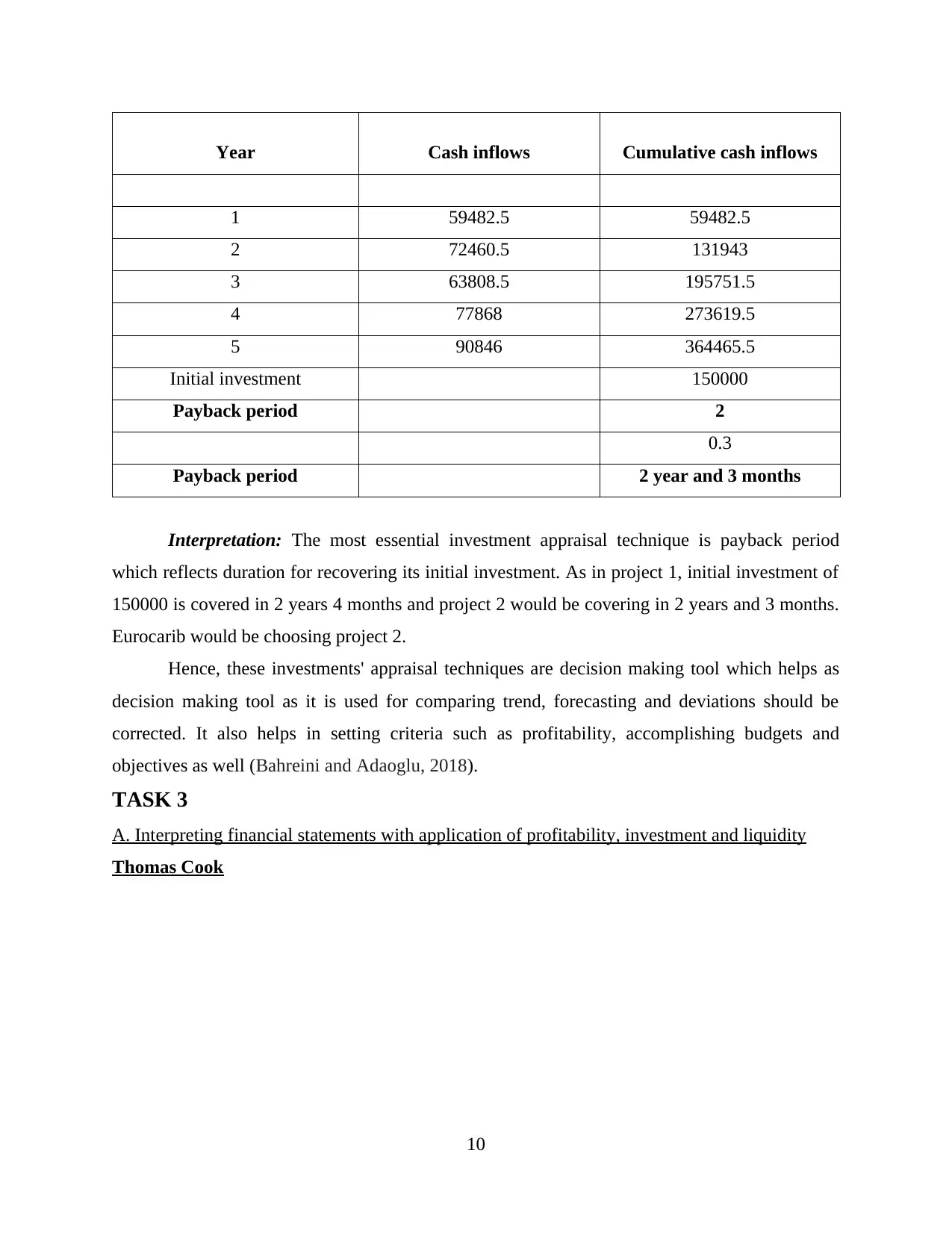
Year Cash inflows Cumulative cash inflows
1 59482.5 59482.5
2 72460.5 131943
3 63808.5 195751.5
4 77868 273619.5
5 90846 364465.5
Initial investment 150000
Payback period 2
0.3
Payback period 2 year and 3 months
Interpretation: The most essential investment appraisal technique is payback period
which reflects duration for recovering its initial investment. As in project 1, initial investment of
150000 is covered in 2 years 4 months and project 2 would be covering in 2 years and 3 months.
Eurocarib would be choosing project 2.
Hence, these investments' appraisal techniques are decision making tool which helps as
decision making tool as it is used for comparing trend, forecasting and deviations should be
corrected. It also helps in setting criteria such as profitability, accomplishing budgets and
objectives as well (Bahreini and Adaoglu, 2018).
TASK 3
A. Interpreting financial statements with application of profitability, investment and liquidity
Thomas Cook
10
1 59482.5 59482.5
2 72460.5 131943
3 63808.5 195751.5
4 77868 273619.5
5 90846 364465.5
Initial investment 150000
Payback period 2
0.3
Payback period 2 year and 3 months
Interpretation: The most essential investment appraisal technique is payback period
which reflects duration for recovering its initial investment. As in project 1, initial investment of
150000 is covered in 2 years 4 months and project 2 would be covering in 2 years and 3 months.
Eurocarib would be choosing project 2.
Hence, these investments' appraisal techniques are decision making tool which helps as
decision making tool as it is used for comparing trend, forecasting and deviations should be
corrected. It also helps in setting criteria such as profitability, accomplishing budgets and
objectives as well (Bahreini and Adaoglu, 2018).
TASK 3
A. Interpreting financial statements with application of profitability, investment and liquidity
Thomas Cook
10
⊘ This is a preview!⊘
Do you want full access?
Subscribe today to unlock all pages.

Trusted by 1+ million students worldwide
1 out of 18
Related Documents
Your All-in-One AI-Powered Toolkit for Academic Success.
+13062052269
info@desklib.com
Available 24*7 on WhatsApp / Email
![[object Object]](/_next/static/media/star-bottom.7253800d.svg)
Unlock your academic potential
Copyright © 2020–2026 A2Z Services. All Rights Reserved. Developed and managed by ZUCOL.




